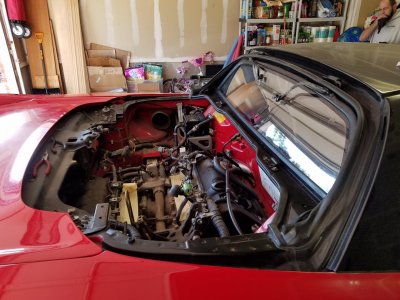Body and Paint Work 24
@NSX_n00b lent a hand and we made huge progress on the car. I'm quite close to pulling the rear subframe. After that, it's off to the paint shop!
First, a big scare. The original plan for the day was to complete the gutting of the front bay. After quickly removing the A/C condensers (they will be replaced), we turned to the blower unit. All was going smoothly until I got under the front of the car to get the lower 2 blower bolts. They spun off easily, but the blower was predictably stuck to the body after years of time. I grabbed the blower to break it free from the body and...
the entire front of the car tilted up!!!! I let go and the front end gently settled back down onto the front jack stands, like a seesaw. "The front end just lifted," I said. "No, it was just the blower moving away from you," Spencer replied. "Watch this," I said and gently pushed up on the front end. The front end easily lifted up about 6 inches and I settled it back down on the jack stands. "Woah." So yeah, our big plan for the day was not going to work. We had removed so much weight from the front end that the car was maybe 50 pounds away from tipping backward. This was bad- I had been planning this for weeks and now we couldn't do any of it. What to do? "I guess we have to take heavy stuff off of the rear," I said with a shrug. Here was our temporary solution until we could get some weight out of the rear. Note- when stripping a NSX to the chassis, remove the rear subframe FIRST.


So, the rest of the day became a game of "so, what's heavy that we can take off?" Our first answer was "the exhaust!" Problem- this is an OEM muffler and cats that have never been off the car in 26 years. I went through this misery when changing to the Fujitsubo Super Ti on my last NSX. My solution there was to soak the rusted nuts in PB Blaster overnight and then hit them with my impact gun. Even then, it took forever because you can't get a straight shot onto any of the bolts with the gun because the exhaust pipe pushes the gun down. So you have to come at them from an angle and pray that you don't strip the nuts. But, here I had not soaked the bolts overnight...because I wasn't planning on removing the exhaust

. The impact gun didn't budge them. It was defeating. What else is heavy? "I don't know, the intake manifold?"
Protected intake ports. Now I can vacuum those leaves.

What else is heavy? "The alternator?"

What else is heavy? "The rear hatch- that's gotta weigh a ton!" (it did)

What else is heavy? "The rear spoiler."

There were some more things. The partial result of our efforts:

After that, the front end did not lift off of the jack stands anymore. So, the big scare was a blessing in disguise. With all that effort, I'm just about ready to take out the rear subframe!




























































